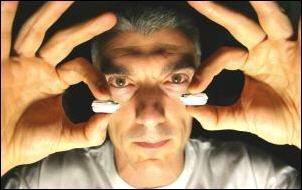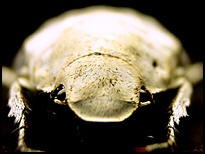Bright white beetle dazzles scientists
An obscure species of beetle could teach us how to produce brilliant white ultra-thin materials, according to a research team led by the University of Exeter.
The Cyphochilus beetle has a highly unusual brilliant white shell. New research by the University of Exeter and Imerys Minerals Ltd. and published in leading journal Science (19 January), reveals the secret to this beetle's bizarre appearance.
The Cyphochilus beetle has evolved its brilliant whiteness using a unique surface structure. At one 200th of a millimetre thick, its scales are ten times thinner than a human hair. Industrial mineral coatings, such as those used on high quality paper, plastics and in some paints, would need to be twice as thick to be as white. According to ISO accredited measurements for whiteness and brightness, the beetle is much whiter and brighter than milk and the average human tooth, which are both considerably thicker.
'This kind of brilliant whiteness from such a thin sample is rare in nature. As soon as I saw it, every instinct told me that the beetle was something very special,' said Dr Pete Vukusic of the University of Exeter's School of Physics. 'In future, the paper we write on, the colour of our teeth and even the efficiency of the rapidly emerging new generation of white light sources will be significantly improved if technology can take and apply the design ideas we learn from this beetle.'
Colour in both nature and technology can be produced by pigmentation or by very regularly arranged layers or structures. Whiteness, however, is created through a random structure, which produces 'scattering' of all colours simultaneously. Using electron microscope imaging, Dr Vukusic studied the beetle's body, head and legs and found them to be covered in long flat scales, which have highly random internal 3D structures. These irregular internal forms are the key to its uniquely effective light scattering. By balancing the size of the structures with the spacing between them, they scatter white light far more efficiently than the fibres in white paper or the enamel on teeth.
Native to South-east Asia, it is believed that the beetle's whiteness has evolved to mimic local white fungi as a form of camouflage.
Biomimicry: Nature's great designs
- In 2000, Californian scientists published research revealing how geckos scurry up walls and stick to ceilings. Their findings could help to develop a novel synthetic adhesive.
- In 2002, a German scientist showed how tiny bumps on the lotus leaf cause rain water to ball up and clean dirt from its surface. This microstructure has been an inspiration for paint and easy-clean furniture fibres.
- In 2005, Dr Pete Vukusic of the University of Exeter showed how butterflies give out fluorescent signals by absorbing and re-emitting ultra-violet light. This technology has been in-place in nature for 30 million years, but scientists are just now developing high emission light emitting diodes (LEDs), which work in the same way. He also worked with cosmetics company L'Oréal to develop a pigment-free photonic make-up based on mimicking butterfly scales.
See similar story "LEDs work like butterflies wings" here.



